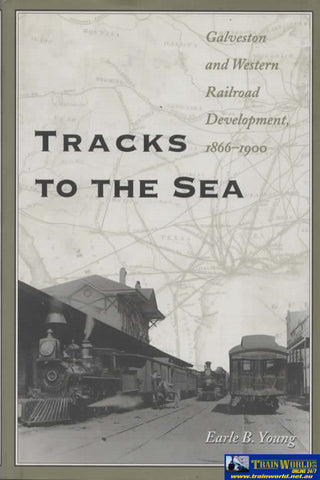Tracks to the Sea: Galveston and Great Western Railroad Development 1866-1900 (HYL-00013)
Product No.: HYL-00013
Title: Tracks to the Sea: Galveston and Great Western Railroad Development 1866-1900
Author(s): Young, Earle B.
Illustrator(s): N/A
Publisher: Texas A&M University
ISBN: 0890968837
Condition: New
Binding: Hardcover
Dust Jacket: New
Edition: 1st Edition
Publication Year: 1999
Features: 160 Pages.
The Industrial Revolution rode into Texas on the railroads. The entire state witnessed the political and economic climate change as the tracks were laid, creating urban centers and even a new governmental body, the Texas Railroad Commission. At the same time, Galveston was a city on a mission to become the primary seaport for the Great West.
Together, the corporate strategy of the railroads and the city's own desire for greatness paved the way for Galveston's growth and transformation into a focal point of Texas railroad ventures. In Tracks to the Sea: Galveston and Western Rail Development, 1866-1900, Earle B. Young traces the efforts of "railroad generals" Jay Gould and Collis Huntington to control Texas' railroad ventures, as well as the struggles of the new railroads built during this era, such as the Houston and Great Northern, the Gulf, Colorado and Santa Fe, and the Houston and Texas Central.
Young also examines the men behind the rails, and the goals and rivalries which shaped the routes and profits of Texas railroads, especially Galveston's George Sealy in his battle with New York's Gould for the route to the thriving seaport and Gould's competition with Huntington over who would dominate the southwestern lines. By the end of the nineteenth century, these railroad builders had brought Galveston to a position of national prominence as a transportation center.
In combination with the ships calling at Galveston's new deep water harbor, the railroads provided connections for all of the western states with markets around the world. Young, using resources from the Rosenberg Library's Galveston History Center, the Kansas Historical Society, and the Library of Congress, devotes chapters to the bankruptcy and revival of Sealy's Galveston's Gulf, Colorado and Santa Fe Railway. Tracks to the Sea is ideal for anyone interested in the history of Texas and Galveston, as well as the dreams, deals, and feuds that shaped the railroad industry of the 1800s.



